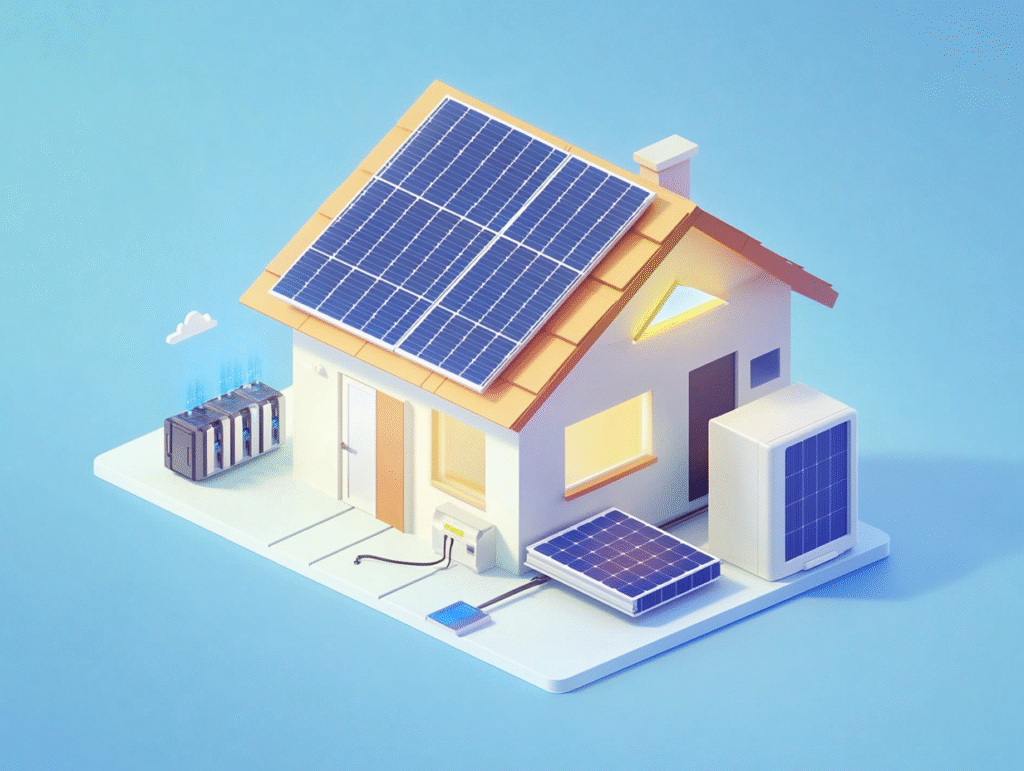What Is a Hybrid Solar Inverter?
A hybrid solar inverter combines the functionalities of traditional solar inverters and battery inverters into one single device. Unlike conventional setups that require separate components for managing solar power and battery storage, hybrid inverters simplify solar installations by integrating both features.
Hybrid inverters convert direct current (DC) from solar panels into alternating current (AC) for household use or grid feed-in, while simultaneously managing battery charging and discharging processes efficiently.
How Hybrid Inverters Work: DC to AC and Beyond
Hybrid inverters operate by converting DC electricity from photovoltaic (PV) panels into usable AC electricity. The process involves advanced power conversion techniques such as Maximum Power Point Tracking (MPPT), which ensures optimal extraction of solar energy.
Additionally, hybrid inverters intelligently manage power flow between the solar panels, battery storage, and the utility grid. During periods of excess solar production, surplus energy charges batteries for later use. When solar production drops, stored battery energy is discharged to maintain a consistent power supply.
Hybrid vs Off-Grid vs On-Grid Inverters: Key Differences
Understanding the distinctions among inverter types can help you choose the right system:
- On-Grid (Grid-Tied) Inverters: Connect directly to the utility grid, require grid power to operate, and have no battery storage capability.
- Off-Grid Inverters: Completely independent from the grid, rely heavily on battery storage, and require extensive battery capacity for continuous power.
- Hybrid Inverters: Offer the best of both worlds, enabling grid connection and battery backup. Ideal for areas prone to power outages or fluctuating electricity prices.
Why Hybrid Inverters Combine Solar and Battery Functions
Hybrid inverters integrate solar and battery management into one device, significantly simplifying solar systems. This integration reduces overall system complexity, lowers installation and maintenance costs, and enhances efficiency by minimizing energy losses associated with separate components.
Additionally, the hybrid inverter’s smart energy management capabilities allow seamless transitions between solar, battery, and grid power, providing uninterrupted power supply even during outages.
Battery Storage with Hybrid Systems: What You Need to Know
Hybrid systems typically use advanced battery technologies such as lithium-ion (LiFePO4). These batteries offer long lifespans, high efficiency, and improved safety. For residential use, typical battery capacities range from 5 kWh to 20 kWh, depending on the home’s energy needs and backup requirements. Popular brands include Pylontech, Narada, Tesla Powerwall, LG Chem, and BYD. Hybrid inverters manage battery charging cycles intelligently, optimizing battery health and ensuring a reliable backup power supply.
In general:
- A 5–10 kWh battery system is sufficient for basic residential use (lights, fridge, Wi-Fi, fans).
- A 15–20 kWh system can support full-home backup including air conditioning and kitchen appliances for several hours.
- Some advanced systems allow modular expansion of battery storage as needs grow over time.
Backup Power and Grid-Tied Flexibility Explained
One significant advantage of hybrid solar inverters is their ability to provide backup power during grid outages. When grid power fails, the inverter seamlessly switches to battery storage, ensuring uninterrupted electricity for essential appliances.
During normal operations, hybrid inverters remain grid-tied, allowing excess solar generation to feed back into the grid, potentially earning credits through net metering.
Understanding MPPT, Efficiency, and Performance
Maximum Power Point Tracking (MPPT) technology enhances the efficiency of hybrid inverters by continuously optimizing solar panel output under varying environmental conditions. Efficient hybrid inverters typically offer conversion efficiencies above 95%, minimizing energy loss and maximizing solar harvest.
Hybrid Inverter Use Cases: Home, RV, and Commercial
Hybrid inverters are versatile, suited for various scenarios:
- Residential Homes: Ensuring reliable power supply and reducing electricity bills through energy storage and net metering.
- Recreational Vehicles (RVs): Providing mobile power solutions with compact systems capable of supporting off-grid adventures.
- Commercial Applications: Managing large-scale solar installations with battery storage for peak load shaving and uninterrupted power.
Common Installation Scenarios and Best Practices
Proper installation is critical for hybrid inverter systems:
- Ensure correct sizing of the inverter and battery capacity based on energy usage.
- Follow manufacturer guidelines for battery and inverter installation to maximize performance and lifespan.
- Regular maintenance, including battery checks and firmware updates, ensures ongoing reliability.
- Choosing the Right Hybrid Inverter for Your Needs
Selecting the right hybrid inverter involves evaluating your specific requirements, including power needs, battery compatibility, and desired backup duration. Consider reputable brands known for reliability, robust support, and proven performance.
Consulting professional solar installers or suppliers can further assist in making informed decisions aligned with your energy objectives.
Extended Insights on Battery Systems and Hybrid Inverters
For larger or specialized setups, such as homes or commercial facilities, hybrid inverters can integrate with more extensive battery storage systems. Advanced battery solutions typically include multiple battery banks connected to provide enhanced storage capacity, often ranging up to 50 kWh or higher, tailored to extensive energy needs.
Split-phase hybrid inverters are especially valuable for regions requiring both 120V and 240V AC power, such as the United States, facilitating compatibility with existing home wiring systems.
Hybrid inverter connected battery solutions offer flexibility to integrate additional batteries easily, ensuring scalability and future-proof energy systems. Brands like EG4 and SMA Smart Connected provide optimized solutions with features such as SMA ShadeFix optimization, enhancing energy production and increasing self-consumption.
Frequently Asked Questions
Q: Can a hybrid inverter work without a battery?
A: Yes, many hybrid inverters can operate without batteries, but adding storage enhances energy independence and backup capability.
Q: How long will a 10kWh battery last during a power outage?
A: A 10kWh battery can typically power essentials like lights, Wi-Fi, refrigerator, and fans for 8–12 hours, depending on usage.
Q: What is the lifespan of a hybrid inverter?
A: Quality hybrid inverters usually last 10–15 years with proper maintenance.
Conclusion
Hybrid solar inverters offer a powerful solution for modern energy challenges, combining efficiency, flexibility, and reliability. Whether enhancing home energy independence, enabling off-grid adventures, or supporting commercial energy needs, hybrid systems represent the future of sustainable solar solutions.
Explore Solocity Global’s range of hybrid inverter products and contact our experts today for tailored solutions and detailed technical information.


